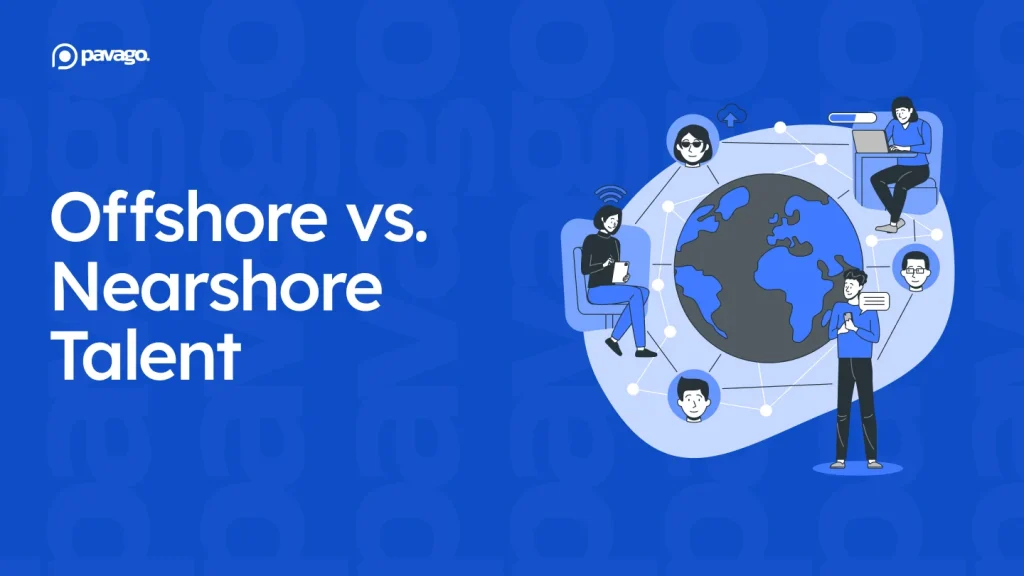Every founder eventually runs into the same problem: hiring great people locally costs a fortune. Salaries climb higher every year, recruiting takes months, and by the time you land someone, you’re already behind.
That’s when you start looking outside your own backyard. You’ll see two options everywhere: nearshore talent and offshore talent. They sound similar, but they aren’t. The differences — cost, proximity, and the size of the talent pool — make a huge impact on your hiring strategy.
So let’s cut through the jargon and talk about what nearshore and offshore hiring really mean, the trade-offs with each, and how to figure out which one makes sense for your business.

What Is Nearshore Talent?
Nearshore talent just means hiring from a country close to yours. If you’re in the U.S., that usually means Latin America — Mexico, Colombia, Costa Rica, Brazil.
The big selling point? Time zones and culture. It’s easier to work with someone whose hours overlap with yours and who shares similar business norms. If you’ve ever tried scheduling daily standups with a team on the other side of the world, you get the appeal.
But here’s the trade-off: nearshore salaries aren’t that cheap. Sure, you’ll save compared to U.S. hires, but you’re not cutting costs in half. The talent pool is also smaller, so competition for the best people is still fierce.
What Is Offshore Talent?
Offshore is the opposite — it means hiring from countries much farther away. Think hiring professionals from Pakistan, South Africa, the Philippines, or Eastern Europe.
The biggest advantage is simple: cost savings and scale. You can often hire senior-level professionals offshore for what you’d pay a junior in the U.S. Not because the talent isn’t good enough, but because there’s a huge difference in cost of living.
And because the talent pool is so much larger, you’re not fighting over the same small group of candidates.
Of course, distance comes with challenges. Time zones may not line up perfectly. Cultural differences can trip you up at first.
But here’s the thing most people miss: the best offshore professionals are used to working with U.S. companies. They already structure their days around your hours, and they’ve adapted their communication styles.
Offshore vs. Nearshore Talent: A Quick Overview
Here’s a quick look at the key factors that separate these two options:
| Factor | Offshore Talent | Nearshore Talent |
|---|---|---|
| Time Zones & Communication | Large time differences may delay communication. Requires asynchronous collaboration. | Generally, more cost-effective, but hidden costs may arise from delays and miscommunication. |
| Cost Considerations | Similar or overlapping time zones allow real-time communication and faster decision-making. | Higher rates than offshore, but cost is balanced by better collaboration and fewer hidden costs. |
| Cultural Fit & Language Barriers | Cultural differences and language barriers can complicate collaboration. | Cultural alignment and language proficiency make collaboration easier and smoother. |
| Talent Pool & Specialization | Large talent pool with specialized skills, especially in tech, engineering, and marketing talent. | Smaller, but highly specialized talent pool, particularly aligned with Western business needs. |
Now, let’s take a closer look at each factor:
1. Time Zones and Communication
One of the most significant differences between offshore and nearshore talent is the time zone overlap. Offshore teams are often located in regions with a considerable time gap from your business.
For example, if your company is based in the U.S., you might work with developers in countries like Pakistan or the Philippines. While this offers cost savings, it can sometimes lead to delays in communication, as while you’re sleeping, your offshore team could be working, and vice versa.
This “round-the-clock” work model can be beneficial for freelancers or short-term projects that don’t require constant interaction, as the work is done during off-hours, allowing your team to be productive even when you’re not around.
However, if you hire offshore talent full-time, you have the flexibility to set working hours that align with your business needs – just like you would with nearshore teams.
Full-time offshore employees can adjust their schedules to fit within your preferred working hours, making real-time communication and collaboration possible, despite the time zone difference.
On the other hand, nearshore teams typically work in similar or overlapping time zones, making real-time communication and quicker decision-making easier.
For U.S.-based businesses, nearshore IT talent (& others) comes from Latin America, which makes it easier to coordinate schedules and have more seamless collaboration without the concerns of time zone differences.
2. Cost Considerations
Cost is a major factor when deciding between offshore and nearshore talent.
Offshore hiring is often the more budget-friendly option, with labor rates in countries like Pakistan, South Africa, and Eastern Europe being significantly lower than in Western markets.
This makes offshore talent a great choice for roles that don’t require constant collaboration or real-time communication, such as back-office tasks or content creation.
However, offshore talent can come with hidden costs.
Time zone differences can create delays in communication and decision-making, which can add time to your project. If your business requires frequent updates or closer collaboration, these delays can lead to inefficiencies.
Nearshore talent, while generally more expensive, offers a balance between cost and collaboration. With overlapping time zones, nearshore teams allow for real-time communication, faster decision-making, and smoother collaboration.
This makes nearshore talent an ideal choice for projects requiring frequent interaction or roles that need to be closely aligned with your business culture.
At Pavago, we offer both offshore and nearshore talent solutions, allowing you to choose the right talent based on your project needs and budget.
Whether you’re looking to save costs or need closer collaboration, we’ve got you covered.
3. Cultural Fit & Language Barriers
Cultural differences can impact collaboration, particularly when it comes to communication styles.
Offshore teams, while highly skilled, may have different approaches to communication, which can be a hurdle – especially for client-facing roles.
In some offshore locations, direct communication may be less common, leading to misunderstandings or slower response times. This can affect customer interactions, where clear, quick communication is critical to maintaining strong client relationships.
Nearshore teams, however, tend to have communication styles that align more closely with Western business norms.
Many nearshore workers, especially in Latin America, are fluent in English and are accustomed to the direct communication and customer service expectations of U.S. businesses. This makes collaboration smoother, particularly for roles where client interaction is key.
4. Talent Pool & Specialization
The size and specialization of the talent pool can vary significantly between offshore and nearshore options.
Offshore teams have access to a vast talent pool, especially in areas like tech, engineering, and customer service. Many offshore locations have a large number of workers with specialized technical skills, including developers, designers, and IT professionals.
While the talent pool may be large, competition for skilled workers can be intense, and it may take longer to find the right fit for your specific needs.
Nearshore talent, although typically from a smaller pool, is often highly specialized and better aligned with Western business needs.
For example, Latin American workers, particularly from countries like Mexico, Argentina, and Brazil, are often highly trained in software development, customer support, and marketing. They are also more familiar with local market trends, which can be especially useful if your business is looking to expand into a neighboring region.
At Pavago, we help find nearshore talent for U.S. businesses from Latin America, specialized in the skills critical to your success.
And if you’re looking for offshore talent, we can help you hire the right professionals in just 3 weeks, ensuring you get the expertise you need, fast.

Frequently Asked Questions
1. What types of roles can be outsourced nearshore?
While nearshore outsourcing is popular in tech and software development, it’s not limited to these areas. U.S. companies also outsource roles in finance and accounting, customer support, marketing, design, sales, human resources, and data analysis to Latin American professionals.
2. How does nearshore outsourcing differ from offshore outsourcing?
The primary difference lies in proximity, time zones, and cultural alignment. Nearshore outsourcing offers closer geographical and cultural ties, leading to smoother communication and collaboration. In contrast, offshore outsourcing often involves greater time zone differences and potential cultural gaps, which can impact real-time communication and project management.
3. Can I get the same quality of talent nearshore as I would locally?
Yes, many Latin American countries produce highly skilled professionals in various fields. With proper vetting and clear communication of expectations, nearshore teams can deliver quality work comparable to local hires.
4. How long does it take to hire nearshore talent?
The hiring timeline can vary based on the role and the specific requirements. However, if you hire nearshore talent through experienced nearshore outsourcing companies, you can get qualified candidates within a few weeks, ensuring a swift and efficient hiring process.
5. What are the cost implications of nearshore outsourcing?
Nearshore outsourcing can offer cost savings compared to hiring locally, especially when considering factors like salary expectations and overhead costs. While rates may be higher than offshore options, the benefits of proximity, cultural alignment, and easier communication often justify the investment.
Conclusion
In the end, the decision to hire offshore or nearshore talent depends on your business needs, budget, and the level of collaboration required for your projects.
Offshore talent is a great choice for cost savings and large-scale tasks that don’t require constant communication.
However, nearshore talent solutions provide a strong balance of cost-effectiveness, cultural alignment, and seamless collaboration, making them ideal for businesses that need real-time communication and high-quality results.
If you’re looking to scale your team with highly skilled nearshore talent from Latin America, Pavago is here to help.
With our expertise in connecting U.S. businesses to top-tier professionals, we ensure quick hiring, seamless collaboration, and the right fit for your business goals.
Book a free consultation today to discover the best talent solutions for your company!
















